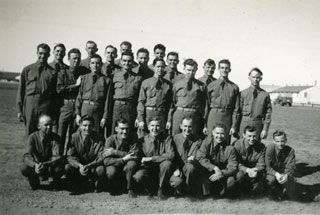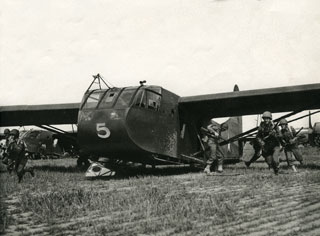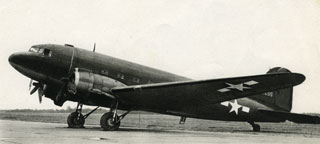Fredric Steinhauser: Glider Training Flights
Fredric Steinhauser grew up in Lamberton, Minnesota. He entered the Army in October 1941, not long before the United States entered World War II. He was sent to Fort Sill, Oklahoma for both basic and specialized training. Fredric was chosen for Officer Candidate School (OCS) for Artillery, and was commissioned a Second Lieutenant in July 1942. He was then assigned as an instructor for the (OCS) Motor School at Fort Sill, until Brigadier General Molitor invited him to join the Thirteenth Airborne as division Artillery Motor Officer, first at Fort Bragg and later at Camp Mckall, North Carolina. During his time at Fort Bragg, Fredric was involved in glider training. He recalled taking three glider flights in a 2009 oral history interview with historian Linda Cameron.
Oral History Excerpts
LC: Talk a little bit about your glider training flights. You mentioned that you went on three of them?
FS: About three. Well, what they did mainly is to train you with the night stuff. You did most of the other stuff in the daytime without a lot of real active sort of thing, you know. It was a training thing. You went and learned about the glider on the ground. In this place you had mock-ups. The mock-ups were built out of wood to be just the size of a CG-4, let's say. Those you'd maybe have ten of those sitting around out in the field somewhere. So, when you were training with those you'd get in trucks from where you were billeted and those trucks would take you to this glider [mock-up] area. So, there were no motors or anything like that around you. You just had these basic things that looked like a glider.
The inside was identical to a CG-4, so that they could run a jeep on there and know exactly where it had to be tied down because, you see, there were always rings in the floor. You'd run the rope through the rings and lash or tie this thing down, so even if it got bumped hard it wouldn't get loose and hit the soldiers that are in the glider. I think we had about 15 people, maybe a little less, in each of these mock gliders, and that's where you practiced.
LC: So that would be about the number of troops that would be carried by a CG-4, right?
FS: That's about right, yes. Now, somebody said that they built a bigger one later on that would carry more…
LC: A CG-13A that could carry thirty fully-equipped troops.
FS: I don't remember the bigger one, because we were from the artillery, and our job was to take either a jeep or a field artillery piece. So when you land, your group of people in there would know just what to do. They'd go and unhook everything, and get it all set up and ready to go so that you and this equipment would move quickly off of wherever you landed to wherever you were to be congregated. We had assigned places where you knew you were to go upon landing so that all these gliders wouldn't have all the people in one big batch in one place. Each of you had your own meeting place, so to speak. Then, once you got there, then it's just like being in the Army; once you're down on the ground, then you function considerably like a normal unit. Artillery in this case.
LC: Describe what those training flights were actually like from the very beginning.
FS: Well, what happened is they would decide when they were going to do this exercise. Of course, the administrators had this all set up so that they knew how many C-47s would be needed for the number of gliders you were going to have in this echelon, and so the average GI, which was me when I was in a glider – when I wasn't in the glider I was the motor officer, but when I was in it I was just another one of the people in this team. So you are brought to this airfield. You got trucked to this place. It can be daylight when you get there even though you know that it is dusk and very soon you'll be flying in total darkness with no light at all.
Let's say that you're ready to go tonight. You've been notified that we're having an exercise. This is a night exercise and the paratroopers and the glider riders are all going to be doing what they do in combat, even if it's just a practice for that. So we would be trucked there, and we already knew which glider was ours because it was marked with what squad went in this one and what squad in that. By the time they got done, they had enough gliders to take these units that we had. Now, there weren't any paratroopers here because they're doing their paratrooping someplace else. We're doing our glider riding here. Then you get all set; you get your field artillery piece, you get your jeep mounted, lashed and loaded, and then you are sitting in there waiting for it to get dark. You sit there, and then finally you get the signal that we're going to go. ...You had the center empty so you could put your jeep or your artillery piece [there], and you sat on the side.
LC: So they had thirteen fully-equipped soldiers and a jeep or an artillery piece on these things?
FS: You could do that, yes. It was tight in there, but… And it didn't have to have both you know. You could have just the men to go on a flight without artillery or a jeep, but later on you had to have transportation to pull the howitzer and stuff, that's all.
So then you sit there, and you find it's getting dark. It might be dusk, I would call it, because the C-47s can see you and you can see them when you start out, but then they get hooked up, as I told you, where the nylon tow line…and I thought the two gliders hooked to a single C-47 were parallel, but maybe that's not possible. Maybe it had to be…
LC: Staggered. [Editor's note: according to one source, when two gliders were towed by a single plane, one was attached to a 350-foot towline, the other to a 450-foot line.]
FS: Yes. Whatever it was, the C-47 came by with a hook, and this hook caught into the towline. When they'd fly by, the hook would go down and grab that elastic cord and the nylon cord – just like a rubber band – it stretches, and nothing is happening, but when it gets stretched out, then it's "Schooo!" - like that. It's like being shot, almost, out of a gun of some kind.
LC: Now, were you guys strapped in?
FS: Oh, yes, definitely. Yes, you were really tight in there. You had the same type of safety belts and stuff everybody else had. You usually had two straps over your shoulder, and then the strap over your stomach.
LC: How high was the C-47 flying when it would snag the glider?
FS: Well, I would have to guess maybe only 75 to 100 feet. They came down low.
LC: Any idea how fast the C-47 was going?
FS: Well, see, I'm sure that they can't get below 100 miles an hour, so they are certainly whipping along. They shut them down as best they can, but if they lose flying speed they'll just drop down, so they can't do that. They have to keep enough airspeed so that they're not going to collapse and go to the ground.
LC: OK, so you're in the air now – you've been jerked up into the air, and you're still on the towline.
FS: Yes.
LC: What happens when they let the towline go?
FS: Well, to begin with, you fly an hour. You see, it isn't just "pick you up here and they drop you over there". To make this realistic, they pick you up with a towline and away you go. So you're sitting in there in the dark, and you don't know anything and you're wondering what's happening. But, if you know what's going on, it's an hour flight. You see, it's got to be realistic for both the pilots in the plane pulling you, the C-47. They have to know what this is like in combat, so they're not going to do something that is real simple. They're going to give them a problem in which you're a part of it, but their problem is to pick you up with a glider and take you to where the assembly place is going to be. That's going to be an hour away someplace, and they don't know - the pilots don't know exactly… They're learning just like you're learning. And you have two sets of pilots; you've got the two pilots that are flying the C-47, who are taking you there as a taxi and, when they get done, they're going to let you loose, and you already have two warrant officers who are the pilots of the gliders.
LC: Did it make you nervous that they were kind of learning, too, at the same time?
FS: Yes, but the whole thing was so damned scary, what difference did it make? You couldn't get out of it, anyway.
LC: So, there was no way out of the plane? You couldn't bail out?
FS: No, no way to get out. When that thing landed, you were with it, and that's why they called them "Flying Coffins", because once you're in that thing and they shut the… The front end opens up so that you can load through the front end, especially if you have a jeep or an artillery piece. If you are walking, you walk up a ramp, of course.
Then once you get to wherever this is, there is a…you have men who have radios with directional beams on them. These people are dropped in advance at the place that you're going to go. They drop them in there and then they set up so that when your plane comes along, you're not lost. Your airplane is gone, so it's just you and your pilot, and you have to know where to land. The C-47 knows where to go because you get the light from this communication box. The communication box gets dropped in with advance people, even in the real war thing. You drop in this guidance thing, and those guys, they're out there alone with this equipment and they set it up, and then when you come along, your pilot of the C-47 can zone-in on where that equipment is and where you're supposed to be flying.
The pilots of the C-47s, of course, are in radio communication with the pilots of your gliders. So they tell you that, "We're just about there, and we're going to let you loose, so, you're on your own." That's what happens then, after you get to a certain point; the C-47 drops you and the cord is off, and now your glider has two warrant officers flying it, and they're now using that equipment on the ground to zero in on where they're going to land. They have to be very accurate, because let's say you have eight gliders and they are stacked up two at a time. Well, you have to be careful so that the second glider isn't going to land on top the first glider. It gets very touchy.
LC: Is it that just one crew that does the signaling from the ground?
FS: Yes.
LC: For all of the gliders that are coming in?
FS: Yes, because, they know in advance – well they can visualize what's happening. The C-47's going to go by, and they are giving them the signal to cut themselves off and go, and they know that the next two guys coming along are going to be landing parallel on this cornfield that they are in and so they've got to get them far enough down on the field so four more batches of people can all land there. What's so scary about this whole thing is you're in the dark and you know these two guys up front really don't know much, either. They are just going by the lights that tell them where to go.
So then we have these gliders, which have a varnished cloth surface – like a drum, almost. When you land in a cornfield and it hits dry corn stalks, it sounds like you've disintegrated. There's so much confusion, because now you've got eight gliders on the ground with 15 people in each one, and they are running around in the dark and they have got to know where to go to their squad or their platoon because that's how they have to get organized or they won't know where to go for their mission.
...And then, of course, after everybody is down and you're now organized in one company, with three platoons and eight or ten squads, you are all on the ground and you're organized now the way the regular Army is organized. So you leave your gliders, and if they are all broken to pieces you don't care. You're out of there and if you have a jeep, you've got to get it going. If you have a howitzer, you have to hook it on to the jeep, and then those people have to drive to wherever our gathering point is.
LC: Did you have any rough landings on your three flights?
FS: I would say all the landings are a little rough because, you know, this thing has no power, and you're just gliding in, and it's got to hit. So, it's going to be rough…
LC: Did anyone get hurt on your training flights?
FS: None of ours, no, but I know on one of our exercises, I think six paratroopers drowned. There again, you have a stack of people and you push them out the door, and while they've looked at maps and stuff, they don't know exactly where to guide their parachute. You can pull on the cords and slide them, but if you don't know what you are coming down to, where do you slide? And so they would land in, let's say, a swamp or a lake, and they'd go down when the parachute would fall on top of them, and they'd get all tangled up in it. I think we lost six on one of these exercises.
LC: OK, so you survived the glider training. What did you receive at the end of the training? Did you get some kind of insignia or…?
FS: Yes. I do have – in fact, if you're a "glider rider", is what we call them, you get the same kind of a insignia, a metal insignia, and you have two – one is for the glider riders and one is for the parachute people. It's a very distinctive thing, yes.
LC: Once you finished the glider training, what did you do after that?
FS: Well, after the glider training, then we were ready to go to Europe. And so that's the time when they moved me from the Airborne to the Ordnance EVAC Company. That would have been about the first of January of 1945. But the 13th Airborne was shipped to France, and it stayed in staging and never was used, because then the war was over.







Source
Steinhauser, Fredric, Interviewee; Linda Cameron, Interviewer, Fredric Steinhauser Oral History Interview, Minnesota Historical Society, 2009.


